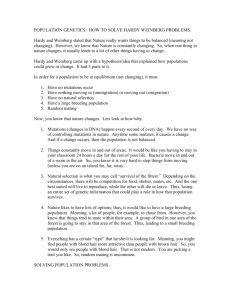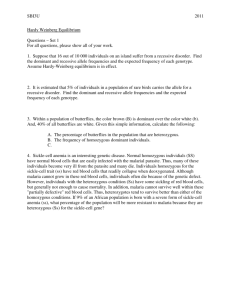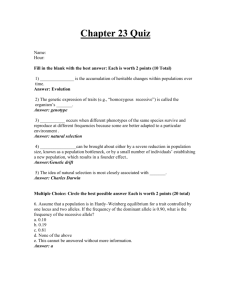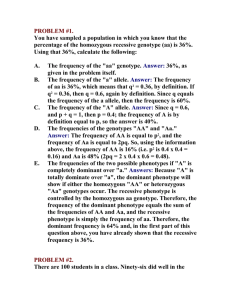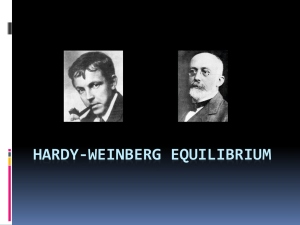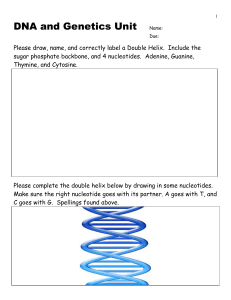population genetics: how to solve hardy weinberg problems
advertisement
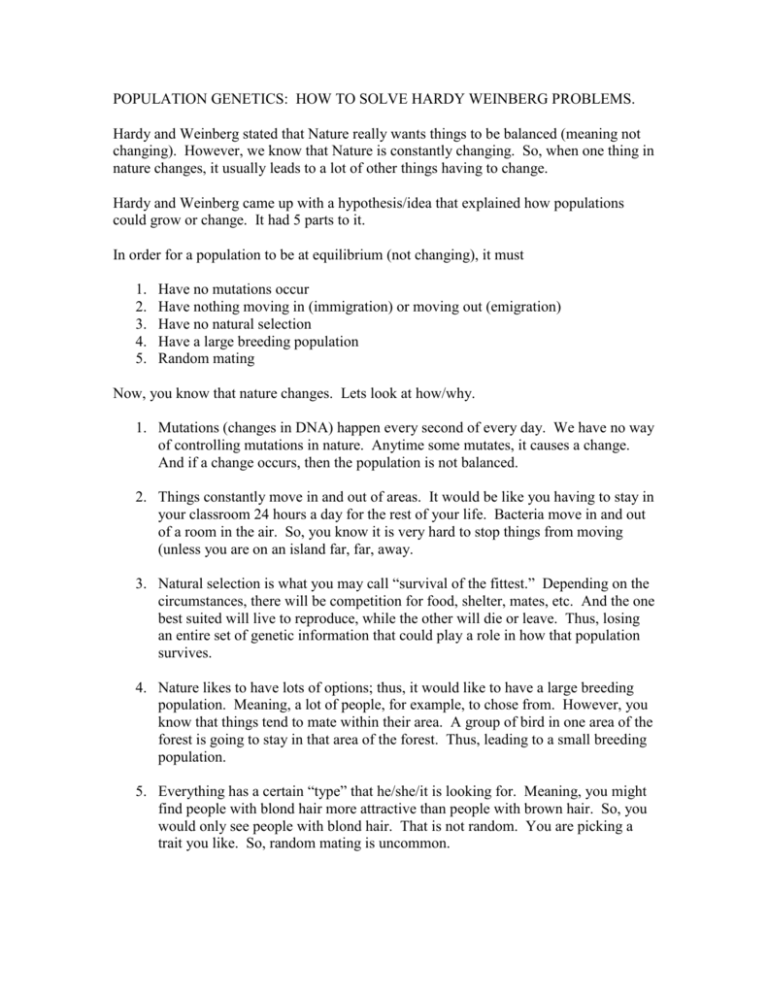
POPULATION GENETICS: HOW TO SOLVE HARDY WEINBERG PROBLEMS. Hardy and Weinberg stated that Nature really wants things to be balanced (meaning not changing). However, we know that Nature is constantly changing. So, when one thing in nature changes, it usually leads to a lot of other things having to change. Hardy and Weinberg came up with a hypothesis/idea that explained how populations could grow or change. It had 5 parts to it. In order for a population to be at equilibrium (not changing), it must 1. 2. 3. 4. 5. Have no mutations occur Have nothing moving in (immigration) or moving out (emigration) Have no natural selection Have a large breeding population Random mating Now, you know that nature changes. Lets look at how/why. 1. Mutations (changes in DNA) happen every second of every day. We have no way of controlling mutations in nature. Anytime some mutates, it causes a change. And if a change occurs, then the population is not balanced. 2. Things constantly move in and out of areas. It would be like you having to stay in your classroom 24 hours a day for the rest of your life. Bacteria move in and out of a room in the air. So, you know it is very hard to stop things from moving (unless you are on an island far, far, away. 3. Natural selection is what you may call “survival of the fittest.” Depending on the circumstances, there will be competition for food, shelter, mates, etc. And the one best suited will live to reproduce, while the other will die or leave. Thus, losing an entire set of genetic information that could play a role in how that population survives. 4. Nature likes to have lots of options; thus, it would like to have a large breeding population. Meaning, a lot of people, for example, to chose from. However, you know that things tend to mate within their area. A group of bird in one area of the forest is going to stay in that area of the forest. Thus, leading to a small breeding population. 5. Everything has a certain “type” that he/she/it is looking for. Meaning, you might find people with blond hair more attractive than people with brown hair. So, you would only see people with blond hair. That is not random. You are picking a trait you like. So, random mating is uncommon. SOLVING POPULATION PROBLEMS. Hardy-Weinberg states: P= the frequency of the dominant allele (so the % of A are in the population) Q= the frequency of the recessive allele (so the % of a in a population_ So p + q = 1 Using the equation: p2 + 2pq + q2 = 1 p2 = frequency of AA (homozygous dominant) 2pq = frequency of Aa (heterozygous) q2 = frequency of aa (homozygous recessive) So, a population genetics problem would look like this. In a certain population of 1000 fruit flies, 640 have red eyes while the remainder have sepia eyes. The sepia eye trait is recessive to red eyes. How many individuals would you expect to be homozygous for red eye color? Okay, lets work this one out together! Answer: 1. q2 for this population is 360/1000 = 0.36 2. q = = 0.6 3. p = 1 - q = 1 - 0.6 = 0.4 4. The homozygous dominant frequency = p2 = (0.4)(0.4) = 0.16. 5. Therefore, you can expect 16% of 1000, or 160 individuals, to be homozygous dominant. Try one more: In the United States, one out of approximately 10,000 babies is born with the disorder. Approximately what percent of the population are heterozygous carriers of the recessive PKU allele? ANSWER: q2= 1/10,000 = 0.0001 q= = 0.01 p = 1 - q = 1 - 0.01 = 0.99 The carriers are heterozygous. Therefore, 2pq = 2 (0.99) (0.01) = 0.0198= 1.98% DO THESE ON YOUR OWN!!!! 1. If you observe a population and find that 16% show the recessive trait, you know the frequency of the aa genotype. This means you know q2. What is q for this population? 2. If 9% of an African population is born with a severe form of sickle-cell anemia (ss), what percentage of the population will be more resistant to malaria because they are heterozygous (Ss) for the sickle-cell gene? 3. There are 100 students in a class. Ninety-six did well in the course whereas four blew it totally and received a grade of F. Sorry. In the highly unlikely event that these traits are genetic rather than environmental, if these traits involve dominant and recessive alleles, and if the four (4%) represent the frequency of the homozygous recessive condition, please calculate the following: A. The frequency of the recessive allele. B. The frequency of the dominant allele. C. The frequency of heterozygous individuals.

